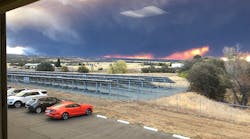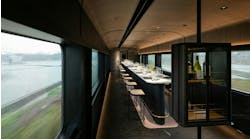I knew about the wildfires in Northern California far ahead of the news appearing in the media. My parents, who thought my New York-based sisters and Midwest-based self had already heard the news, began sending us photos of my hometown.
Northern California Exposed
I grew up in Chico, CA, a short drive down the hill to the now-lost town of Paradise. Chico has a population of 92,000 that ebbs and flows depending on whether California State University Chico is in session.
The best way to describe my hometown is to say you head north from Sacramento and drive through farmland for an hour and a half. Located within the Sierra Nevada valley, Chico is one of the most populated towns north of Sacramento. In comparison, Paradise had a population of 26,500 — mostly made up of fixed- and lower-income folks.
When you think of California, you don’t think of the sparsely populated hills, farm land and woods that exist in Northern California. Chico is landlocked and dependent on itself, unless you have the means to drive 1.5 hours to Sacramento. When the recession hit, this region of the country saw upwards of 17 percent unemployment. The mall I grew up walking is typical in that most of its big box stores are now shut up and have been for years.
Humanitarian Crisis
Those store fronts are now emergency response centers for FEMA as they attempt to negate the tens of thousands of new homeless in the region. Camp Fire, which burned more than 150,000 acres over 17 days, spared Chico because of the dedicated and fearless emergency response teams that were deployed. But those fleeing the smaller towns around the metropolis have relocated to Chico, adding almost 30,000 new residents to the already at-capacity city.
There aren’t enough spots in shelters for them. Many who were on the brink of homelessness now find themselves in tent cities across parking lots in Chico. This is a humanitarian and housing crisis without a clear answer. A real estate agent I went to high school with posted on Facebook that before the wildfire there were about 250 homes for sale. Only 80 remain, with many of those pending.
An Opportunity to Rebuild
My dad and many of the folks I grew up with have been part of the effort to help those displaced. Speaking with him about the next steps, my dad mentioned he was concerned about those in Paradise who hadn’t lost everything. While it’s stated that the city is gone, a few homes and businesses still remain.
A Sunday school teacher I had growing up owns a car shop in Paradise that was untouched by the wildfire; a miracle, yes, but without a town with cars to tune, what’s the good of a car shop? Those whose homes were spared are exceptionally lucky, but without schools, shops or the local hospital, what are the next steps?
I’m reminded of the post-war era during which thousands of homes were quickly constructed across America to accommodate the soldiers returning home. From the depths of this tragedy, it’s my belief that Paradise can provide the grounds for innovations in city planning and architecture.
What is needed are architects and developers who take a Usonian approach to rebuilding a town from scratch. (Frank Lloyd Wright’s Usonian developments attempted to create beautiful, wellness-centered homes that were affordable to the average family in contrast to the standardized tract housing going up across the country.)
Paradise was a city made up of the vulnerable peoples of California — retirees, the disabled, those living on welfare. To develop the city without them in mind would be to turn them out and worsen the country’s homelessness.
Now is the Time for Design
My dad discussed the chart of tragedy with me. We are currently in the heroic response moment when people band together, help one another and have an optimistic view of the future.
But after the heroic response comes the crash of disillusionment. The truth of the situation sinks in; donations slow to a trickle; the news turns their cameras away — at least until an anniversary approaches and they’re able to ask, “what exactly has happened to this place in the last 10 years?”
► Beyond the Wildfire: Designing for Resilience
It’s important for developments to come together during the heroic response period. Now is the time for designers and city planners to sit down and discuss the next steps if Paradise is going to be reborn.
Opportunities include:
- Pre-fabricated housing with innovative materials and designs. While most pre-fab homes are highlighted now and again as examples of cool “experimental” architecture, this is an opportunity for them.
- Retirement medical communities. Although not the sunny beaches of Florida, Northern California is a beautiful location full of fishing, woods and mountains.
- Public transportation to connect rural Northern California to city hubs like Sacramento and San Francisco.
- Experimental educational design.
- Expanding Chico, which already hosts facilities like Sierra Nevada Brewery, Blue Diamond nuts, Klean Kanteen, Third-Love and almost every brand of rice you buy stateside.
Paradise will soon be forgotten, but it, Chico and the surrounding areas should be on architects’ radars. Imagine an entire city built with affordable health and wellness in mind. Imagine the innovations that can come from a holistic study on the impact of design on populations.
While this tragedy continues, we should be looking toward what next steps exist and how the area can be redesigned. It’s a terrible, heartbreaking tragedy, and I don’t want to lose sight of all that was lost, including the loss of life. It’s also an opportunity to use design and city planning to help vulnerable populations. Ignoring this opportunity will mean Camp Fire will be an ongoing crisis rather than an example of what tragedy can transform into.



